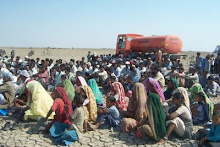The Times of India:Tuesday,September 27,2011.
RAJKOT: In a bid to augment the livelihood of saltpan workers in Gujarat, Bhavnagar-based Central Salt and Marine Chemicals Research Institute (CSMCRI) has embarked on a project to provide them its patented technology to produce export quality salt and extract valuable chemicals from waste generated in the process.
The saltpan workers or 'agariyas', as they are called in Gujarat, is one of the most backward community, with over 70 per cent living below poverty line under harsh conditions in the Little Rann of Kutch (LRK).
The CSMCRI project titled 'saltpan cluster development programme' has been funded by the state industries department to train the saltpan workers to produce better quality salt that an fetch them good income and is being implemented with support from Agariya Heet Rakshak Manch (AHRM), a non-governmental organization (NGO), working for the saltpan workers.
This initiative of the institute is also aimed at arming the saltpan workers with technology to extract valuable chemicals from bittern (the liquid pumped off after the salt is harvested from the brine), which could be sold to industry adding to their income.
"Under this project we train saltpan workers to use our patented technology using which they can produce better quality salt and also utilize the waste or reject from the manufacturing process to extract valuable non-common salts for industrial use," said a senior scientist at CSMCRI Dr V P Mohandas, adding that they have already trained over 500 saltpan workers.
This would augment their livelihood as they would be able to get more income from the salt and the rejects also, he added.
"Most of the saltpan workers are exploited by middlemen who buy salt at low price saying it is poor in quality and then sell it at higher price to big companies," he said.
"The workers presently produce only salt. They throw away the waste bittern that is generated. We have given them technology to extract from bittern chemicals like low sodium salt for hypertension patients, potash which is used in fertilizers and magnisium chloride for industrial use," Mohandas said. pti
"For every one tonne of salt similar amount of bittern is generated. And if instead of throwing away the bittern if valuable chemical are extracted and sold to industries it would add to the income of saltpan workers," he added.
Mohandas said they have already demonstrated such extraction at small scale, now they would be doing it at a larger scale. The saltpans in Maliya (Rajkot) are rich in sulphate content from bittern. There sulphate of potash could be obtained which is a better fertilizer than murate of potash obtained from bittern of saltpans in LRK region.
Under the project, saltpan workers are linked directly to the industries through NGOs SEWA and Anandi in LRK and Rajkot districts respectively by forming small collectives or associations, he said.
Some of the companies now directly purchasing salt and chemicals from saltpan workers include Gujarat Heavy Chemicals Ltd, Punjab Alkalies, Indian Rayon and Gujarat Alkalies and Chemicals Ltd.
According to AHRM, over 12,000 families of saltpan workers, including children, migrate from more than 100 village bordering LRK to produce salt.
The LRK is also home of the wild ass or the Godhkhar in local language and is declared as a protected area. The inland salt produced from LRK accounts for 40 per cent of salt produced in Gujarat, which in turn is also largest producer of salt in the country.
LRK characterizes a unique eco-system having saline desert and wetland with high biodiversity. It is also flood plain of eight rivers. The ecosystem supports various livelihoods of people living in and around LRK that consists of saltpan workers, marginal farmers, fishermen and charcoal makers.
















.jpg)
.jpg)
.jpg)
.jpg)













No comments:
Post a Comment